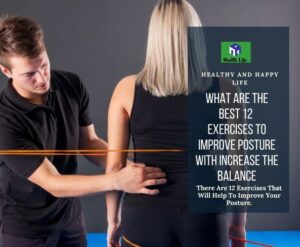There is more to having good posture than just appearing attractive. It promotes the growth of strength and flexibility in your body, as well as a sense of equilibrium. All of these things can contribute to a reduction in muscular soreness and an increase in energy levels throughout the day. Continue reading more about what are the most suitable exercises to improve posture of the body.

In addition, maintaining correct posture lowers the strain placed on your muscles and ligaments, which in turn lowers the chance of injury.
You will become more conscious of your muscles as you work on improving your posture, which will make it simpler for you to correct your own posture in the future. You could even become conscious of some imbalances or regions of tension in your body that you were previously unaware of as you work on improving your posture and being more aware of your body.
Continue reading to find out how to perform 12 different exercises that can make you appear slightly taller.
1. Child’s Pose.
This seated forward bend elongates and extends the spine, as well as the glutes and hamstrings. The child’s position is an effective way to relieve stress in the lower back as well as the neck.
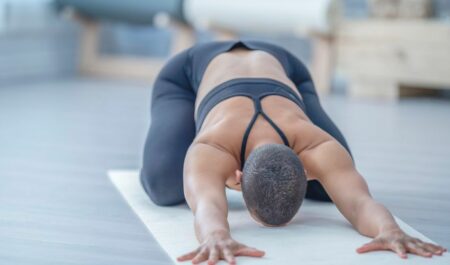
How To Do This:
- Place your knees close together, bring the tips of your big toes together, and splay your heels out to the side as you sit on your shinbones.
- You should squat down with your hands in front of you and fold forward at the hips.
- Bring your hips back down to your feet and keep them there. If you find that your thighs won’t go all the way down, you may give them some support by placing a pillow or a folded blanket under them.
- You might try turning your head to the side or gently placing your forehead on the ground.
- Maintain an open stance by keeping your arms outstretched or resting them on your side.
- Take a long, slow breath in from the back of your rib cage and into your waist.
- Rest comfortably in this position for up to five minutes while maintaining a deep breathing pattern.
2. Forward Fold.
Your spine, hamstrings, and glutes should all feel more relaxed after performing this standing stretch. Additionally, it extends your hips as well as your legs. While you are extending your back in this way, you should feel as though your entire behind is opening up and getting longer.
How To Do This:
- While standing, bring the tips of your big toes together and keep your heels slightly apart from one another.
- Fold forward at the hips while bringing your hands to rest on your hips.
- Put your hands on a block or let them fall to the ground as you release them. It doesn’t matter if your hands don’t make contact with the ground; the goal is to get as far as you possibly can.
- You should stretch your spine by bending your knees ever-so-slightly, massaging the joints in your hips, and bending your hip joints.
- Make sure that your chin is tucked into your chest, and then let your head hang down limply to the ground.
- Hold this position for as long as you can, up to a minute.
3. Cat Cow Pose
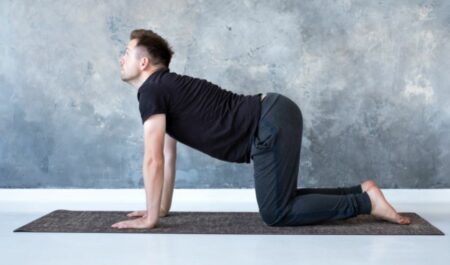
Your spine will receive a stretching and massaging benefit while doing cat cow. While doing so, not only does it aid to improve blood circulation, but it also helps to release stress in your upper back, shoulders, and neck.
How To Do This:
- Get down on your hands and knees and make sure that your weight is distributed equally across all four points of contact.
- You should inhale to gaze up, and as you do so, you should drop your abdomen toward the ground and stretch your spine.
- Exhale, then bury your chin into your chest as you arch your back toward the sky and pull your abdominal muscles in tight.
- Keep doing this exercise for at least one full minute.
4. Standing Cat-Cow Pose.
By standing while performing the cat-cow stretch, you may assist loosen up any tension that may be present in your back, hips, or glutes.
How To Do This:
- Maintain a modest bend in your knees while standing with your feet around hip-width apart from one another.
- Put your hands on your thighs or extend them in front of you as a sign of greeting.
- Lengthen your neck, move your chin into your chest, and curve your spine.
- Then you should rotate your spine in the other direction while looking upward, lifting your chest, and doing so.
- Each posture should be held for a total of five breaths.
- Keep moving in this manner for the next few minutes.
5. Chest Opener.
The chest may be opened up and stretched with the help of this workout. Because sitting for long periods of time might cause your chest to slide inward, this tip is especially helpful if you spend the most of your day sitting. Working out your chest muscles might also help you stand up more straight.
How To Do This:
- Take a position where your feet are roughly hip-width apart from one another.
- Put your arms behind your back and link your fingers together while squeezing the palms of your hands together. If your hands are unable to reach each other, grab hold of a towel.
- Maintain a straight line across your head, neck, and spine while you look in front of you.
- As you raise your hands closer to the ground and rise your chest toward the ceiling, inhale and begin the movement.
- Hold this position for five full breaths while focusing on your breathing deeply.
- Let go and take a few deep breaths to relax completely.
- At a minimum of ten times, repeat.
6. Perform A High Plank.
While at the same time helping to strengthen your shoulders, glutes, and hamstrings, the high plank position is excellent for relieving pain and stiffness throughout your entire body. Additionally, it assists with the development of balance as well as strength in the core and back, all of which are essential for proper posture.
How To Do This:
- Get down on the floor in a position where you’re on all fours, then extend your legs, elevate your heels, and bring your hips up.
- Pull your stomach in against your spine and tighten the muscles in your arms, legs, and abs.
- Stretch out the back of your neck, make sure your throat is relaxed, and stare at the ground below you.
- It is important to remember to maintain your shoulders back and your chest open.
- Keeping this position for up to a minute at a time is your goal.
7. Side Plank.
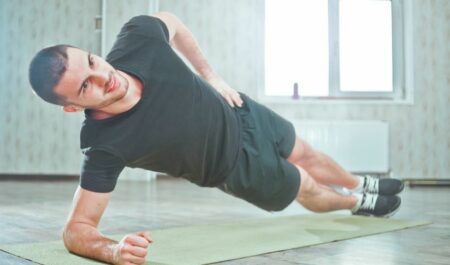
You can keep the natural curve in your spine and straighten your legs by performing a side plank exercise. The muscles in your sides and glutes get a good workout from this invigorating stance. To better support your back and enhance your posture, you should work on strengthening and aligning these muscles.
How To Do This:
- From the high plank position, move your left hand such that it is slightly in front of the center of your body.
- Move your weight to your left hand, bring your ankles together, and elevate your hips to do this move.
- Put your right hand on your hip, or reach your right arm all the way up toward the ceiling.
- You can provide yourself with additional support by lowering your left knee to the ground.
- Maintaining this stance requires you to engage your abdominal muscles, side body, and glutes.
- Position your body such that a straight line can be drawn from the top of your head to the bottom of your feet.
- Take a look in the direction of the front of your body or up toward your hand.
- Maintain this position for up to thirty seconds at a time.
- On the other side, repeat the process.
8. Downward-Facing Dog.
This is a forward bend that may be utilized as a resting posture to help your body achieve a state of equilibrium. Your back will feel much better after practicing the downward-facing dog stance, which also helps to build strength and align your back muscles. Regular participation in the activity helps to improve posture.
How To Do This:
- While lying on the floor with your stomach facing up, press into your hands and elevate your heels while simultaneously tucking your toes beneath your feet.
- Bring your sitting bones closer to the ceiling by bringing your knees and hips up toward them.
- You should stretch your spine while slightly bending your knees.
- Either position your ears so that they are in line with your upper arms, or tuck your chin so that it is completely tucked into your chest.
- Maintain a strong pressure onto your hands while keeping a modest lift in your heels.
- Hold this position for as long as you can, up to a minute.
9. Pigeon Pose.
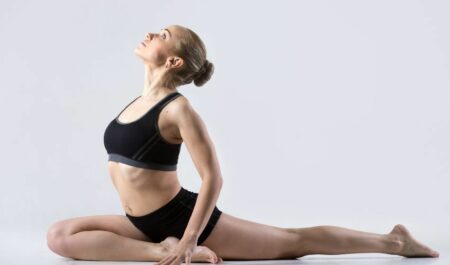
This is a hip opener that also loosens up your spine, hamstrings, and glutes at the same time. Pigeon position is beneficial for stretching not just your quadriceps but also your sciatic nerve. If you open up and stretch certain areas of your body, it will be much simpler for you to rectify imbalances in your posture.
How To Do This:
- Get down on the ground on your hands and knees, keeping your hands a little bit in front of your shoulders and your knees below your hips.
- You should flex your right knee and position it behind your right wrist. At the same time, you should slant your right foot out to the left.
- You should let the medial aspect of your right shin to rest on the floor.
- Move your left leg backwards until it is resting on the floor, then straighten your knee and put your weight on it.
- Check that your left leg is extended in a straight back position (and not to the side).
- While keeping your arms outstretched in front of you, slowly lower your torso until it is resting on the innermost part of your right leg.
- Maintain this posture for at least 60 seconds and up to a minute.
- You may release the posture by gradually bringing your hands closer to your hips while simultaneously elevating your body.
- It will be repeated on the left.
10. Thoracic Spine Rotation
Your back will feel less stiff and painful as a result of this workout, which also improves your stability and mobility.
How To Do This:
- Get down on all fours, then bring your hips back down to your heels, and put your hands on your shins for support.
- Put your left hand behind your head and stretch your left elbow out to the side while doing so.
- Maintain your right hand on your forearm or move it into the middle of your body so that it may rest on your shoulder.
- Exhale as you extend the front of your torso and twist your left elbow up towards the ceiling.
- While maintaining this position, take one deep breath in and one deep breath out.
- Bring it all the way back down to its starting position.
- Perform this exercise anywhere from five to ten more times.
- On the other side, repeat the process.
11. Glute Squeezes.
This exercise helps to relieve discomfort in the lower back while also strengthening and activating the buttocks and glutes. Additionally, it improves the functioning and alignment of your hips and pelvis, which ultimately results in improved posture.
How To Do This:
- Position yourself so that you are lying on your back with your knees bent and your feet at around hip-distance apart.
- Maintain a distance of roughly one foot between your feet and your hips.
- Put your hands facing downward and rest your arms along the sides of your body.
- As you raise your feet closer to your hips, exhale as you do so.
- After ten seconds of holding this posture, pull your hands farther apart from your hips and return to this starting position.
- Keep moving in this manner for the next minute.
- Repeat this exercise several times throughout the day.
12. Isometric Rows.
The discomfort and stiffness that might result from sitting in one position for an extended period of time can be alleviated by performing this exercise. Pulling exercises, such as isometrics, train the muscles in your shoulders, arms, and back, providing you the strength to maintain a healthy posture.
How To Do This:
- Take a seat in a chair that has a padded back.
- You should bend your arms so that the palms of your hands are facing each other and your fingers are facing forward.
- Exhale as you pull your elbows back into the chair behind you and push your shoulder blades together. Continue doing this for a few seconds.
- Hold this position for ten seconds while you focus on taking deep breaths.
- During your inhale, gradually return your body to the beginning position.
- This movement should be repeated for a full minute.
- Perform this exercise many times at different points throughout the day.
FAQS
Rows that are isometric. The discomfort and stiffness that might result from sitting in one position for an extended period of time can be alleviated by performing this exercise. Pulling exercises, such as isometrics, train the muscles in your shoulders, arms, and back, providing you the strength to maintain a healthy posture.
“But creating a habit of proper posture may take some time,” explains Dr. Bang. It takes roughly four to six weeks, the same as with any other type of fitness plan, to see any substantial changes.
Form the habit of sitting in the appropriate position. Because your muscles have not been conditioned to support you in the appropriate position, it is possible that at first it will not feel comfortable to do so. A slouching posture can be improved by performing exercises that strengthen the muscles in the core and buttocks, as well as back extensions.
Incorporating some posture exercises into your workout regimen will help you sit and stand taller in your regular life, which you’ll want to do to avoid the aches and pains that can come with sitting or standing with poor posture for an extended amount of time.
